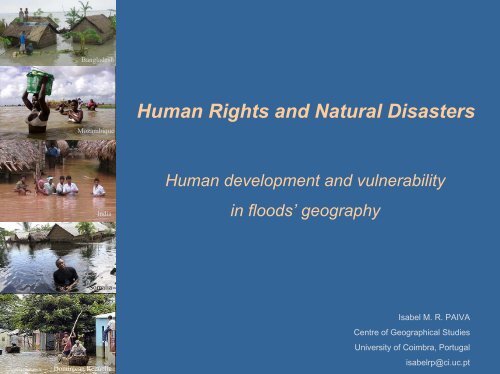Human Rights and Natural Disasters - Ruhr-Universität Bochum
Human Rights and Natural Disasters - Ruhr-Universität Bochum
Human Rights and Natural Disasters - Ruhr-Universität Bochum
Create successful ePaper yourself
Turn your PDF publications into a flip-book with our unique Google optimized e-Paper software.
Bangladesh<br />
Mozambique<br />
India<br />
Somalia<br />
Dominican Republic<br />
<strong>Human</strong> <strong>Rights</strong> <strong>and</strong> <strong>Natural</strong> <strong>Disasters</strong><br />
<strong>Human</strong> development <strong>and</strong> vulnerability<br />
in floods’ geography<br />
Isabel M. R. PAIVA<br />
Centre of Geographical Studies<br />
University of Coimbra, Portugal<br />
isabelrp@ci.uc.pt
Discussion <strong>and</strong> goals<br />
Universal Declaration of <strong>Human</strong> <strong>Rights</strong><br />
Article 1<br />
All human beings are born free <strong>and</strong> equal in dignity <strong>and</strong> rights. (…)<br />
Article 3<br />
Everyone has the right to life, liberty <strong>and</strong> security of person.<br />
But the reality shows that:<br />
The poor are the most severely affected by all natural disasters<br />
And the numbers tells us that:<br />
From 1975 to 2000, people who belong to the low-income<br />
category accounted for about 50% of those killed in floods.<br />
(UN/International Strategy for Disaster Reduction)
Discussion <strong>and</strong> goals<br />
. Call for attention for a human rights problem related to human<br />
development, vulnerability <strong>and</strong> impact of natural disasters;<br />
. Show the reality about natural disasters around the world,<br />
including floods, <strong>and</strong> its relationship with human development<br />
degree;<br />
. Emphasize how poorest communities are the most vulnerable<br />
to natural disaster, particularly to negative impacts of floods;<br />
. Show how poverty <strong>and</strong> vulnerability are a terrible vicious<br />
cycle in the natural disasters context.
Terminology<br />
<strong>Natural</strong> Disaster<br />
A serious disruption, caused by natural phenomena, of the<br />
functioning of a community or a society causing widespread<br />
human, material, economic or environmental losses which<br />
exceed the ability of the affected community or society to cope<br />
using its own resources.<br />
EM-DAT: The OFDA/CRED International Disaster Database<br />
consideres:<br />
for a disaster to be entered in their database at least one of<br />
the following criteria has to be fulfilled:<br />
�10 or more people reported killed<br />
�100 people reported affected<br />
�a call for international assistance<br />
�declaration of a state of emergency
Vulnerability<br />
. The human condition or process resulting from physical,<br />
social, economic <strong>and</strong> environmental factors, which determine<br />
the likelihood <strong>and</strong> scale of damage from the impact of a given<br />
hazard. (UN/Development Program)<br />
. The conditions determined by physical, social, economic,<br />
<strong>and</strong> environmental factors or processes, which increase the<br />
susceptibility of a community to the impact of hazards.<br />
(UN/International Strategy for Disaster Reduction)<br />
Resilience<br />
The capacity of a system, community or society<br />
potentially exposed to hazards to adapt, by resisting or<br />
changing in order to reach <strong>and</strong> maintain an acceptable<br />
level of functioning <strong>and</strong> structure.<br />
This is determined by the degree to which the social system is<br />
capable of organizing itself to increase its capacity for learning<br />
from past disasters for better future protection <strong>and</strong> to improve<br />
risk reduction measures.<br />
(UN/International Strategy for Disaster Reduction)
Floods in natural disasters context<br />
Evolution of hidrometeorological World distribution disasters by (1970 type (1991-2005) – 2005)<br />
Flood<br />
Wind Storm<br />
Biological disasters<br />
Earthquake <strong>and</strong> Tsunami<br />
Drought<br />
Slide<br />
Extreme temperature<br />
Wild Fire<br />
Volcano<br />
2 %<br />
5 %<br />
4 %<br />
4 %<br />
6 %<br />
8 %<br />
Floods are the hidrometeorological disaster with<br />
largest growth in last 35 years<br />
14 %<br />
25 %<br />
33 %<br />
Source:<br />
EM-DAT: The OFDA/CRED<br />
International Disaster<br />
Database, UCL, Brussels,<br />
Belgium<br />
Floods are the natural disaster with major<br />
incidences worldwide<br />
Source: UN/ISDR
Floods are among the most common <strong>and</strong> most devastating<br />
natural disasters.<br />
(WMO - World Meteorological Organization)<br />
Floods have the greatest damage potential of all natural<br />
disasters worldwide <strong>and</strong> affect the greatest number of people.<br />
(UN – Guidelines for Reducing Flood Losses)<br />
Flooding causes over one-third of the total estimated costs<br />
<strong>and</strong> is responsible for two thirds of people affected by<br />
natural disasters.<br />
(UN – Guidelines for Reducing Flood Losses)<br />
From 1992 to 2001 a reported 1.2 billion people were affected<br />
<strong>and</strong> 96 500 killed by flooding.<br />
(International Federation of Red Cross <strong>and</strong> Red Crescent Societies, 2002)
<strong>Natural</strong> disasters, human development <strong>and</strong> vulnerability<br />
During the 1990s, 96 per cent <strong>and</strong> 99 per cent respectively of<br />
the annual average number of persons killed or affected by<br />
hazards resided outside of the US/Canada <strong>and</strong> Europe.<br />
(G. Bankoff, Mapping vulnerability, 2004, p.29)<br />
More than 95% of all deaths as a result of natural disasters are<br />
in the least developed countries, <strong>and</strong> these same nations have<br />
the greatest number of people affected by natural disasters.<br />
(UN – Guidelines for Reducing Flood Losses)<br />
From 1992-2001, countries of low human development (LHD)<br />
have accounted for just one-fifth of the total number of<br />
disasters, but over half of all disaster fatalities. On average 13<br />
times more people die per reported disaster in LHD countries<br />
than in countries of high human development (HHD).<br />
(International Federation of Red Cross <strong>and</strong> Red Crescent Societies,<br />
World <strong>Disasters</strong> Report, 2002)
<strong>Natural</strong> disasters, human development <strong>and</strong> vulnerability<br />
<strong>Natural</strong> disasters <strong>and</strong> inequalities of development<br />
Disaster losses, total <strong>and</strong> as share of<br />
GDP, in the richest <strong>and</strong> poorest nations<br />
1985-1999<br />
Top 10 disasters costs as a proportion<br />
Hurricane Andrew (USA), one<br />
of GDP (1974 – 2003)<br />
of the most expensive disaster<br />
represented only about 0.3% of<br />
Annual average victims/100 000 population<br />
the<br />
1974-2003<br />
GDP of USA.<br />
Richest Poorest<br />
Source: UN/ISDR<br />
Source: Adapted from EM-DAT: The OFDA/CRED International Disaster<br />
Database, UCL, Brussels, Belgium<br />
Recurrent floods in Bangladesh<br />
represent an annual loss of 5%<br />
of the country's GDP.<br />
Source: Adapted from EM-DAT: The OFDA/CRED International Disaster Database,<br />
UCL, Brussels, Belgium
Floods, human development <strong>and</strong> vulnerability<br />
Floods <strong>and</strong> inequalities of development<br />
Top 10 most expensive flood disasters (1974 – 2003)<br />
Top 10 flood disaster costs as a proportion<br />
of GDP (1974 – 2003)<br />
Source: Adapted from EM-DAT: The OFDA/CRED International Disaster Database,<br />
UCL, Brussels, Belgium<br />
Source: Adapted from EM-DAT: The OFDA/CRED International Disaster Database, UCL, Brussels, Belgium<br />
The looses caused by floods in Bolívia in 1982 were evaluated in<br />
19,8% of GDP (gross domestic product). – World Meteorological Organization<br />
In Honduras, Hurricane Mitch put the country’s economic development<br />
back 20 years. (International Federation of Red Cross <strong>and</strong> Red Crescent Societies)
Floods, human development <strong>and</strong> vulnerability<br />
Floods <strong>and</strong> inequalities of development<br />
The poor are the most severely affected by all<br />
natural disasters, including floods.<br />
Low income<br />
Low er middle<br />
income<br />
Upper middle<br />
income<br />
High income<br />
People killed in floods by income class (1975-2001)<br />
1 %<br />
23 %<br />
26 %<br />
Source:<br />
Adapted from UN/ISDR<br />
50 %
Floods, human development <strong>and</strong> vulnerability<br />
Why are the poorest communities the most vulnerable to floods ?<br />
Connecting vulnerability <strong>and</strong> low human development<br />
Physical factors<br />
. <strong>Human</strong> pressure on building in high risk areas (floodplains)<br />
. Low resistance houses<br />
. Environmental degradation (deforestation, soil degradation<br />
<strong>and</strong> erosion, availability of water, etc)<br />
. Low mobility of populations<br />
. Lack of disaster preparedness measures<br />
. Lack or deficiency of early warning <strong>and</strong> forecasting systems<br />
www.praticalaction.org www.news.bbc.co.uk
Floods, human development <strong>and</strong> vulnerability<br />
Why are the poorest communities the most vulnerable to floods ?<br />
Connecting vulnerability <strong>and</strong> low human development<br />
Socio-economic factors<br />
. Poverty <strong>and</strong> high population density<br />
. Lack of scholar formation <strong>and</strong> information<br />
. Marginality <strong>and</strong> social segregation<br />
. Heavy dependence on agriculture, one of the most affected<br />
activity by floods<br />
. Lack or fragility of support from governments to provide<br />
resources to vulnerable communities<br />
. Lack of social security <strong>and</strong> insurance<br />
. Lack of resilience<br />
http://news.bbc.co.uk
Floods, human development <strong>and</strong> vulnerability<br />
Connecting vulnerability <strong>and</strong> low human development.<br />
A spatial perspective
Floods, human development <strong>and</strong> vulnerability<br />
Connecting vulnerability <strong>and</strong> low human development.<br />
A spatial perspective
Floods, human development <strong>and</strong> vulnerability<br />
Over the last 30 years:<br />
. 88% of the total people reported killed<br />
. 96% of the people reported affected<br />
In the last 15 years:<br />
lived in Africa <strong>and</strong> Asia.<br />
. 99% of total people affected by floods<br />
. 96% of total people killed by floods<br />
lived in developing <strong>and</strong> least developed countries.
Floods, human development <strong>and</strong> vulnerability<br />
Connecting vulnerability <strong>and</strong> low human development<br />
Poverty affects people's capacity to protect themselves <strong>and</strong><br />
their assets, as well as their ability to live in areas having<br />
less exposure to risk.<br />
The vulnerability of societies to natural disasters is clearly<br />
linked to poverty <strong>and</strong> weak planning. Dramatic urban growth,<br />
with the development of increasingly fragile infrastructure, is<br />
one factor that places the poor at higher risk from natural<br />
disasters.<br />
(UN -General Assembly/Economic <strong>and</strong> Social Council)<br />
From this point of view, vulnerability signifies a<br />
lack or a deficiency of development.
Floods, human development <strong>and</strong> vulnerability<br />
Connecting vulnerability <strong>and</strong> low human development<br />
Disaster vulnerability <strong>and</strong> poverty are mutually reinforcing.<br />
Lack of<br />
resilience<br />
Poverty<br />
Heavy<br />
social <strong>and</strong><br />
economic<br />
impacts<br />
Increase<br />
vulnerability<br />
It's a terrible vicious cycle<br />
High exposure of<br />
persons <strong>and</strong> their<br />
settlements<br />
<strong>Natural</strong> disaster<br />
occurrence
Final remarks<br />
. Poverty is a keyword for analysis on the natural disasters<br />
impacts because of the increasing of population vulnerability.<br />
.When a disaster strikes, it destroys not only existing wealth,<br />
but also income opportunities <strong>and</strong> livelihoods, thereby further<br />
increasing the vulnerability of the already poor population.<br />
. The floods effects are particularly destructive because they<br />
do not kill outright, but eliminate the ability for already<br />
marginal populations to improve or even continue their lives.<br />
. The necessity to integrate the risk <strong>and</strong> vulnerability reduction<br />
into policies, plans <strong>and</strong> programmes for sustainable<br />
development.<br />
. The urge to implement prevention <strong>and</strong> protect systems against<br />
natural hidrometeorological phenomena, including floods, in the<br />
poorest livelihoods, in the context of rising of weather extreme<br />
events.
Do you remember?<br />
www.praticalaction.org Diário de Coimbra, Portugal<br />
Article 1<br />
All human beings are born free <strong>and</strong> equal in dignity <strong>and</strong> rights. (…)<br />
Article 3<br />
www.frenchentree.com<br />
http://news.bbc.co.uk<br />
Everyone has the right to life, liberty <strong>and</strong> security of person.<br />
www.praticalaction.org<br />
http://news.bbc.co.uk<br />
http://news.bbc.co.uk<br />
www.tribuneindia.com
Thank you !

















